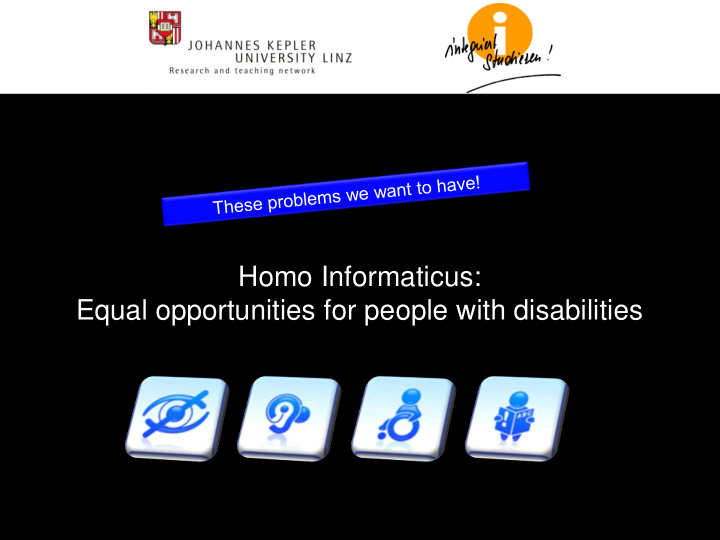



Homo Informaticus: Equal opportunities for people with disabilities Quelle: http://internet.ls-la.net/
I agree! But we move away from the desktop!
I agree! y-phil.deviantart.com
Transformation (Polanyi)
Advancement in Inclusion ICT/AT eAccessibility
Transformation • Individual/Deficit/Medical Model (epidemiological approach) • Environmental Model ( adaptability approach ) • Social Model ( social constructionist or social meaning approach ) [SÖDER 89, GUSTAVSON 97]
Person / User Centred „Person fits the Technology“ „Technology fits the Person“
V. Bush: Memex “…when one of these items is in view, the other can be instantly recalled HOW? merely by tapping a button ”
HCI: Desktop: WIMP 1962 W INDOWS M ENUE 1965 I CONS P OINTER D. Engelbart (Stanford Research Laboratory)
Desktop limited number or elements limited number or actions (actuators) unlimited number or activities „one click away “
Evolution limited number or elements limited number or actions (actuators) unlimited number or activities „one click away “
HCI • flexible - multi-media - multi-modal • adaptive/profile • universal/standard USERfit
Gutenberg Revolution Johannes Gutenberg (Georg Christoph Lichtenberg, 1742 – 1799)
Content Handling Presentation
Gutenberg Disability
Content Content Content Meta-Daten Handling Handling Meta-Daten Presentation Presentation Presentation
ENIAC (ca. 1945) IBM 010 (ca. 1955) Altair 8800 (ca. 1973) Apple I (ca. 1976)
ENIAC (ca. 1945) IBM 010 (ca. 1955) Altair 8800 (ca. 1973) Apple I (ca. 1976)
Disability „the concepts of normal / abnormal (disabled / non disabled) http://www.watzlawickehrenring.at/paul-watzlawick.html loose their meaning as individual patterns. “ [Paul Watzlawick] Homo Informaticus has no disability
Traditional Interfaces complexity exclusion
HCI Interfaces IKT/MCK basierte Werkzeuge: Standardisierte, universelle Schnittstelle complexity inclusion
Universal Design, eAccessibility, Design for All • e-publishing • e-government Assistive Technology (AT) • e-business • e-health • e-learning • e-libraries • e-care • smart house / environment • adaptive, wareabel, pervasive, ubiquitous, ... • virtual, augmented ... reality • eLiving, AAL • eCommunication, AAC • ... • INTERNET OF THINGS
Transformation “ Science Finds, Industry Applies, Man Conforms. ” Motto of World Exhibition 1933, Chicago “ People Propose, Science Studies, Technology Conforms. ” Donald A. Norman (1993), Things That Make Us Smart
ICT/AT (Sensor) Revolution Individual Skills Access/Interaction Sensors/Actuators Sensors/Actuators USER AT HCI SYSTEMS/SERVICES Sensor-AT/eAccessibility
1. Interacting with the Environment “The Internet of Things links the objects of the real world with the virtual world , thus enabling anytime, anyplace connectivity for anything and not only for anyone.” (Sundmaeker, Guillemin, Friess & Woelfflé, 2010, p.9]
1. Internet Revolution 1.33*10 50 Atoms on this planet (http://education.jlab.org/qa/mathatom_05.html) 10 78 to 10 82 Atoms on the visible universe ( www. universe today.com ) optical, quantum computers, DNA computing 5.0 * 10 50 operations per second and per kilogram matter Kurzweil, Ray (2005). The Singularity is Near
2. Sensor Technology & AT identify/assess sense measure any controlled and measurable activity interact/communicate ac(tua)t(e) participate “making sense”
Fear 2.0
What is Disability? Humberto Maturana / Francisco Varela: Tree of Knowledge http://www.uniklinik-ulm.de/?id=9719
What is Disability? Humberto Maturana / Francisco Varela: Tree of Knowledge http://www.mh-hannover.de/4991.html
What is Disability? Humberto Maturana / Francisco Varela: Tree of Knowledge
Inclusion 1) Enabling independent individual activity (Assistive Technology) 2) Empowering Communication (Accessibility) 3) Facilitating Participation (Social Inclusion) http://carnetphilosophique.blogspot.co.at http://nwasharedworkspace.com C.G. Escher
Disability http://www.kunst-fuer-alle.de
Advancement in Inclusion “Measure what can be measured, and make measurable what cannot be measured.” Galileo Galilei (1564 - 1642) http://crackiitjee.com
Recommend
More recommend